| << . 1 . 2 . 3 . 4 . >> |
| Author |
Message |
gcrank1
Member
|
# Posted: 27 Jul 2022 10:14pm - Edited by: gcrank1
Reply
When my old, tired agm's didnt really have any beans left the cheapie 1000W 'psw' inv. would shut down.
I got another year out of them by pulling the worst battery out of the bank (load tested bad), going to a smaller inverter and not using energy hogs.
When I was down to one agm bat, I paralleled in a big old car bat (850cca?) thinking it might dump some big amps quick to start stuff; seemed to work. Then the agm faded and I replaced it with a seemingly decent used 100Ah 'marine dc'. That got me through last year....then last winter I bought into LFP; 2x 100Ah 12v (I was going to have to spend some serious bucks anyway on new LA so I threw the money at the LFP's)
Whadadiff!
All that to say....when the bats loose enough beans they wont run stuff with a start up load. Just like when a LA starting battery reads good voltage but wont turn the car engine over enough to start.
|
|
paulz
Member
|
# Posted: 27 Jul 2022 10:27pm
Reply
This one handles the startup. The three things I've been trying to run, toaster, micro and coffee maker, all draw about 1500w and all run for about one minute before the inverter shuts down. The display says around 22 degrees C, manual says it shuts down at 60.
My 500ah of LFP have been hovering around 13.4, plenty of juice there.
|
|
ICC
Member
|
# Posted: 27 Jul 2022 10:49pm - Edited by: ICC
Reply
Quoting: paulz My 500ah of LFP have been hovering around 13.4, plenty of juice there
The LFP could be able to do that, I am guessing. FWIW, 1500 watts at 12 volts is 1500/12 = 125 amps, and that is w/o allowing for whatever inefficiency factor the inverter introduces. If 10% the amps jump to 135 or so. If 20% then even more amps. Good LFP may very likely be able to handle that rate of discharge. But, being used who knows?
{EDIT... I found a valence datasheet that states max comtinuous load is 150 amps (on good batteries I assume). 300 amps for 30 seconds. }
What happens to the voltage reading on the battery when that inverter load is applied? If the voltage drops below 12 volts the amps drawn increase to try and make the watts. That becomes a rapid downward spiral.
Not saying that is the case. It could be a possibilty though.
|
|
ICC
Member
|
# Posted: 27 Jul 2022 11:38pm - Edited by: ICC
Reply
A passing thought.... I don't trust voltmeters on equipment until I verify them by comparing readings to those from a known good reliable meter. Especially meters built into cheap equipment.
If the graphical display drops significantly but the numerical readout does not, it would seem logical to think one of the two is incorrect, would it not?
|
|
ICC
Member
|
# Posted: 27 Jul 2022 11:54pm
Reply
Quoting: paulz From the battery bank I have 6awg cables, about 4', with a Victron low voltage cutoff set at 12.5 and a 50 amp breaker in the circuit
Hmmmm?
6 AWG wire may not be up to the task. But I don't havemy PC with me so cannot run numbers through the rlectrical calculator and I struggle with finding that info poking at s 6" screen with a finger.
Was that 50 amp breaker a mistype? Maybe 150 amp?
|
|
paulz
Member
|
# Posted: 28 Jul 2022 11:21am - Edited by: paulz
Reply
Thanks ICC. Tried it again this morning, paying more attention. Under 1,460W load, the inverter V reading drops down to 11.3 at the point where it shuts off. Meanwhile, the SCC meter reads 13.0 and the Drok meter reads 12.2. It's all wired up as in the diagram below. So maybe a test with larger cables direct to batteries is in order. I still don't know why the inverter doesn't sound an alarm like it says it should.
My Valence batts are rated at 150A continuous draw, and I have 4 working. I could also take it outside and hook it to the truck with the motor running.
Also the Victron is 100A, I think the Drok is only 50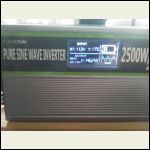
20220728_074622.jpg
| 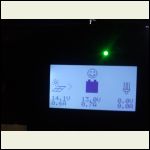
20220728_074559.jpg
| 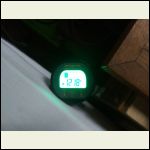
20220728_080837.jpg
| 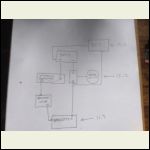
20220728_081110.jpg
|
|
|
paulz
Member
|
# Posted: 28 Jul 2022 02:53pm - Edited by: paulz
Reply
Well, you guys called it. I added a second set of cables, ran the nuker at 1,550, no problem. Voltage at the inverter stayed at 13.
Not out of the woods yet though. I added the extra cables direct from batteries to inverter, bypassing the Victron, Drok and breaker. To keep them in the circuit I would need larger cables for those legs in addition to the inverter cables. Or perhaps it's one of those causing the resistance. Or I could just go direct from bat to inverter.
Anyway thanks again guys, good thing I didn't send it back.
|
|
Nobadays
Member
|
# Posted: 28 Jul 2022 03:05pm
Reply
At least you found your problem. It looks like 1/0 cable will handle 150amps, a little more than you will likely pull. Fine stranded copper is best.
|
|
|
paulz
Member
|
# Posted: 28 Jul 2022 04:51pm - Edited by: paulz
Reply
Yep, at least I found out it's not then inverter I been cussin at.
I have some 1/0 I think cable, and the connectors and hydraulic crimper. More to follow..
What prompted revisiting this, as I don't use the toaster or microwave much, was bringing out the 45 cup electric coffee maker from the city to keep up with my wife's insatiable thirst, the 1 quart propane French press just won't keep up. Me, I'm one cup in the morning and off to work.
|
|
paulz
Member
|
# Posted: 28 Jul 2022 06:30pm
Reply
Good day for this, too tired to work on the roof.. So, I replaced the bat + to voltage protector and protector to circuit breaker with 1/0, about a foot each. The old cables were premade auto battery cables, marked 4G but I could feel them getting warm. Left the double 6awg cables to the inverter. Microwave test, inverter now showing 12.8 and shut off halfway through the 2 minute test. Hmm.
Next I removed the circuit breaker, 100W Ebay cheapo, and it passed the 2 minute test, inverter voltage at 13. So it looks like this breaker is part of the problem. Lastly I removed one of the double cables to the inverter, it also passed the test, voltage 12.9. So for now I'll just bypass the breaker.
No new 12v equipment for me, time to start changing over.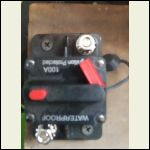
20220728_1516241.j.jpg
| 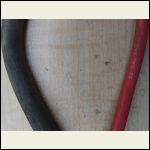
20220728_151749.jpg
|  |  |
|
|
ICC
Member
|
# Posted: 28 Jul 2022 09:02pm
Reply
For breakers I find the best DC rated breakers are those sold by Midnite Solar. Some are DC only, some are AC or DC. All tend to be a bit pricey but they are very very good. They do need to be mounted in an approved case to meet code. For non-inspected installations as long as they are safely installed a container/case/cabinet could be improvised. Most, maybe al, are DIN rail mounting types and DIN rails are available from many sources.
|
|
paulz
Member
|
# Posted: 29 Jul 2022 10:37am - Edited by: paulz
Reply
This morning I ran the coffee maker for 10 minutes at 1,550W. Inverter handled it no problem but my batteries felt it after watching TV last night plus the usual draws. They'll recover today but I doubt I would get away with it in winter. Probably need to go back to propane fueled coffee. I did toast my morning bagel no problem though..
I know I should have a breaker back in the circuit. All of the car/RV type inverters like this never mention it in the instructions, maybe they figure it's a given.
One minor annoyance is the inverter fan kicking on with a substantial load (not the TV) and it's pretty loud in a 300sf cabin. Can't hear the wife's jabbering over it, maybe that's not so bad..
|
|
gcrank1
Member
|
# Posted: 29 Jul 2022 10:58am
Reply
Iirc, Blue Sky stuff is highly regarded, too?
Those type of cheap CB's are only good as a quick disconnect (if that), not to be relied upon to 'break' under the supposed trip amps and known to bridge (right term?) internally sometimes when they do (BAD thing).
LOTs of info And the right stuff recommended over at 'diysolarforum.com).
You dont have to join up to read the posts.
|
|
ICC
Member
|
# Posted: 29 Jul 2022 04:35pm
Reply
Quoting: gcrank1 cheap CB's are only good as a quick disconnect
Not even as that if they introduce sufficient resistance into the line to cause a voltage drop.
|
|
paulz
Member
|
# Posted: 29 Jul 2022 04:56pm
Reply
The cable attachment studs on both the inverter and the breaker are only 6mm. And the cables that came with the inverter are also whimpy, not marked but smaller than they should be.
|
|
ICC
Member
|
# Posted: 29 Jul 2022 04:57pm
Reply
I use 2 Midnite breakers on each charge controller; one on the input from PV and the other on the + line to the batteries. That makes it super easy to disconnect and reconnect if needed for maintenance or whatever. No tools are needed.
Plus a breaker on every + line coming off the batteries; inverter, DC well pump, etc. I do not like fuses for 2 reasons. Keeping track of spares can be a problem. Pulling a fuse to break a DC circuit that does have a load can result in a big arc flash that can actually burn you or start a fire. There is a youtube video that shows a very impressive flame arcing as a cartridge fuse was pulled.
|
|
gcrank1
Member
|
# Posted: 30 Jul 2022 08:40pm
Reply
Correction:
It is 'Blue Sea' stuff that is highly regarded for elec for marine use. Makes it great for landlubbers too.
|
|
ICC
Member
|
# Posted: 30 Jul 2022 09:40pm
Reply
That is very good marine equipment with an impressive lifetime "if not happy, return it for full refund or replacement" warranty and worldwide service, which can be important in the marine world. The biggest downfall when it comes to uses on land is that it is not approved under the NEC. But if that is not of concern Blue Sea is excellent, and there is no comparison the any of the off-name imported brands. My bus has a few Blue Sea components.
|
|
Ominous Ann
Member
|
# Posted: 13 Feb 2023 04:57pm - Edited by: Ominous Ann
Reply
You guys seem to have a lot of good answers.
So I'm looking at a 4000 watt 12V to 120 v Volfvert inverter. I'd like to run a couple 15 amp circuits looks like it comes with 30 amp fuses. Which seams off
Any thoughts ?
Color code chart for those fuses says green is 30 amps.
I was looking at another one, just 3000 watts and it came with 7 amp fuses ? Maybe they were fusing each of their four outlets at 1/4 total capacity ?
Crazy, they cost about the same amount.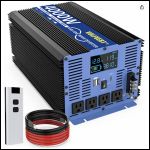
Screen_Shot_202302.png
| 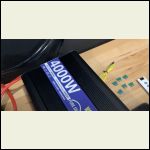
Screen_Shot_202302.png
|  |  |
|
|
gcrank1
Member
|
# Posted: 13 Feb 2023 05:28pm - Edited by: gcrank1
Reply
If you want/need 4000W load on 120v you do Not want to be using 12vdc to feed it.
You have to wire And 'fuse' for the max inverter capability.
The simple math goes like this (no accounting for 'inefficiencies'):
4000W / 12v = 334A
That is Massive! (and will deplete a 400Ah bat bank in basically 1 hr)
Even at 24v it is still 167, more manageable but....
48V is what you should be thinkin.
84A WAAYYY better in terms of wire gauge, fusing and potential line loss And especially costs.
|
|
Brettny
Member
|
# Posted: 13 Feb 2023 05:37pm
Reply
What's the load your trying to run. Circuit amperage is dictated by the breaker size and the breaker size is dictated by the wire size..the wire size is dictated by the appliance amperage. I
t's a bit confusing but in short you need to know what load you want to run or expect to run before picking a inverter.
|
|
Bruces
Member
|
# Posted: 13 Feb 2023 05:49pm
Reply
Those fuses are 12 volt fuses ,they wouldn’t be for the 120v side of the inverter ,just low voltage input .
|
|
travellerw
Member
|
# Posted: 13 Feb 2023 05:59pm
Reply
Quoting: Bruces Those fuses are 12 volt fuses ,they wouldn’t be for the 120v side of the inverter ,just low voltage input .
The picture is grainy but I think it clearly show 2100W constant and 4000W peak. LOL YA OK.. I would be shocked if the peak was over 2500W on that inverter.
Anyway 6 30A fuses are 180A, which is 2100W. So that seems about right.
I'm all for being frugal.. but I would touch that one. It pays to spend more and get a decent brand.
|
|
travellerw
Member
|
# Posted: 13 Feb 2023 06:02pm
Reply
Quoting: travellerw The picture is grainy but I think it clearly show 2100W constant and 4000W peak. LOL YA OK.. I would be shocked if the peak was over 2500W on that inverter.
Well I stand corrected.. I looked at the second picture and it show 8000W peak.. LOL LOL LOL...
Really pick something different, from a more recognized brand. Also try to stick to 2000W and under for 12V (I try to stay under 1500W). Then you can use manageable wires, with reasonably sized terminals and things won't get hot (be a fire hazard).
|
|
Ominous Ann
Member
|
# Posted: 13 Feb 2023 06:12pm
Reply
Interesting stuff.
It says 4000 constant and 8000 peak.
Which in terms of input draw would be upwards of
4000/120 = 33 amps or 330 amps of DC which would require about -8 gauge wires from the house bank which in this case is 4 100 amp hour 12V batteries.
I'd guess the four 120 outlets are all fused together at 30 amps but that doesn't seem right.
Seems they should be 15 amps max like a normal plug.
I haven't bought it yet so yeah, please let me know what you think. It's amazon's recommended brand and it gets high ratings so I guess it's not exploding or starting fires LOL.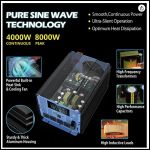
Screen_Shot_202302.png
| 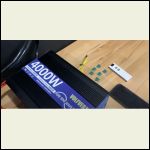
Screen_Shot_202302.png
|  |  |
|
|
Ominous Ann
Member
|
# Posted: 13 Feb 2023 06:15pm - Edited by: Ominous Ann
Reply
A 12 volt fuse, ( and yur right they do look like DC fuses ) at 30 amps would only produce 120 volts at 3 amps. Which is worthless to me. I have a 3 amp draw just on the RV refrigerator.
I don't know what I'm missing here but I'm sure missing something. Don't want to find out the hard way. I need at least one 15 amp line at 120 volts.
15 amps at 120 volts is only 1800 watts
Says it's a 4000 watt inverter ?
|
|
gcrank1
Member
|
# Posted: 13 Feb 2023 06:19pm - Edited by: gcrank1
Reply
Wish you had started a new thread on this (still can) instead of having it buried in this old one.
Hopefully Steve_S will weigh in on your inquiry; you can bank on his recommendations.
|
|
Ominous Ann
Member
|
# Posted: 13 Feb 2023 06:37pm - Edited by: Ominous Ann
Reply
My bad
You are right about the draw. The loads are a toaster oven that doesn't run more than about 15 minutes tops. That's the main draw and the fridge, which says it's about <50 watts on average per hour, but, wants to be plugged into a 15 amp line, so.
I have 800 watts in panels on the roof which on average will produce 3.5 kWh a day. Or almost enough to top off some depleted batteries. I have four 100 amp hr batteries which in an ideal world would be 8 but ;-/ I don't have room for 8. The Renogy sustem I'm buying (haven't bought anything yet) has a 12 volt charge controller and the inverter (assuming I buy this one ) has a 12 volt input. So while wiring higher voltages is easier it's still building a toaster no matter how you slice it.
The typical fix is to double up on smaller wires from the bank to the inverter but ;-/ haven't tried that one yet. Most of my experience is wiring big trucks and we always used -8 gauge wire and fought with it.
I'm still not clear how a 4000 watt inverter has 30 amp DC fuses. The numbers don't crunch.
Just thought of something
What if it used all six fuses at once for a 180 amp draw. That kinda works out but who does that ?
you'd think they'd have one 200 amp breaker.
I'm missing something ????
|
|
Ominous Ann
Member
|
# Posted: 13 Feb 2023 07:05pm
Reply
Found a video on changing those fuses. They're on the inside of the device after the splitter and inevitably before polishing the signal into 120 ac
Two per line. or 6 amps AC per line in the case of this particular inverter which isn't the 4000 watt model.
Still not clear on why they use multiple fuses on the input side instead of one big easily accessible breaker.
|
|
gcrank1
Member
|
# Posted: 13 Feb 2023 08:12pm - Edited by: gcrank1
Reply
Ok, a few things for thought:
1) dont double up on wires. Yes, it will help carry the load but it doesnt make 2x8ga. into a 4 (example only)
Iirc (and the info is online) it bumps the wire gauge by 2; ie, 2x8 makes close to a 6?
But, heres the bite, you have to fuse both because if one goes all the load goes to the other and maybe starts a fire. You always want the inverter close as possible to the battery bank anyway so using the properly gauged wire and properly done lugs is just the right thing to do.
2)Friends dont let friends buy Renogy! If you question that go to 'diysolarforum.com' and read up on it.
3)If your batteries are any version of lead acid you can really only use 50% of the Ah's, and much better if only 30%. And you need to get them recharged to top asap. Use more than 50% and/or not recharge asap and you kill them.
LFP you can cycle out 90% regularly and they dont care if you dont recharge asap. They are Great! Cant recharge below freezing though; that is the only downside Ive found.
4)Be aware that many 'Pacific Rim' inverters are not what they are labeled to be or what the ad copy says. If something doesnt add up, regardless of the 'puffed reviews', you might just run.
Also, ignore the peak/surge rating on those; it is only for a micro-second then they shut down/fail. Only go by the continuous rating and maybe even reduce that by 25%.
For 'big draw/short run time' stuff; use the gen rather than grossly oversize an inverter. The bigger they are the more amps they draw doing 'little stuff' most of the time. Bad trade.
|
|
| << . 1 . 2 . 3 . 4 . >> |

